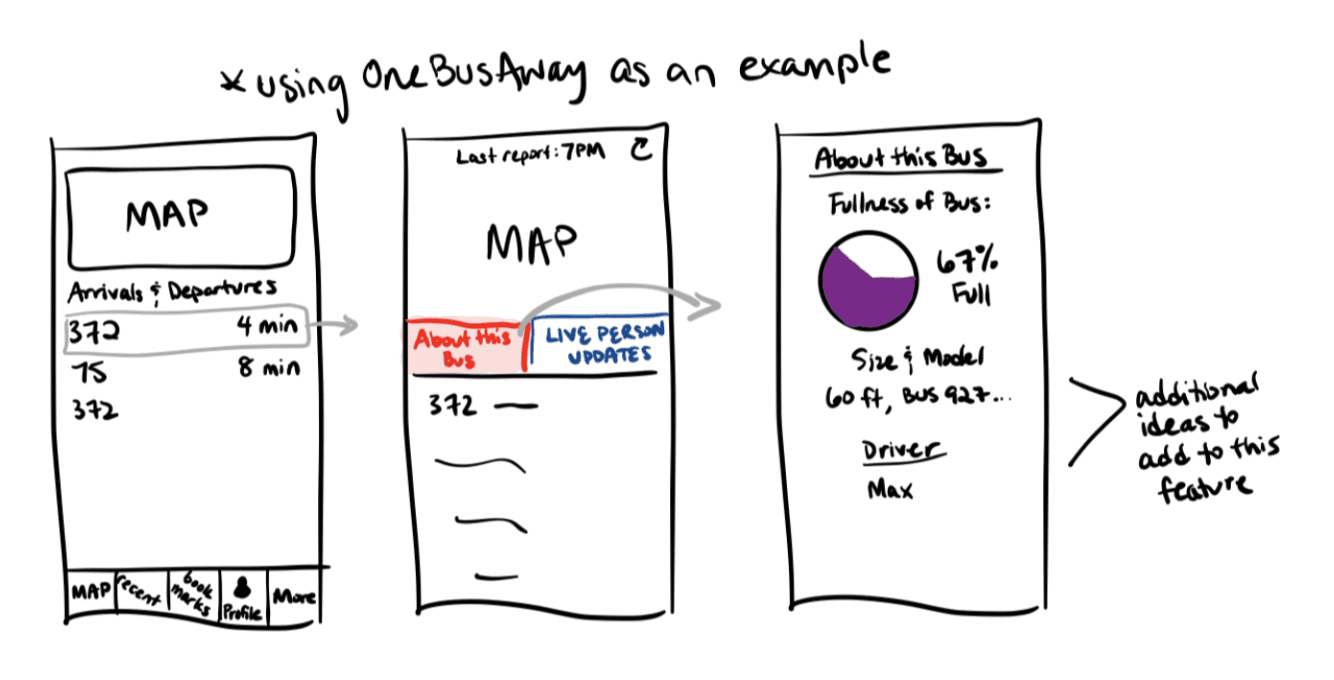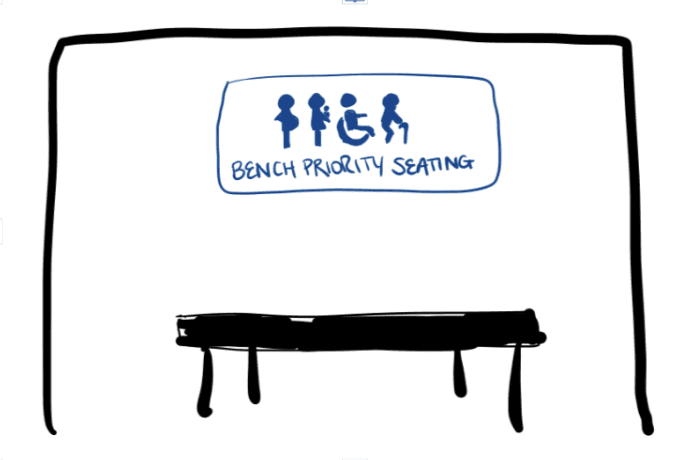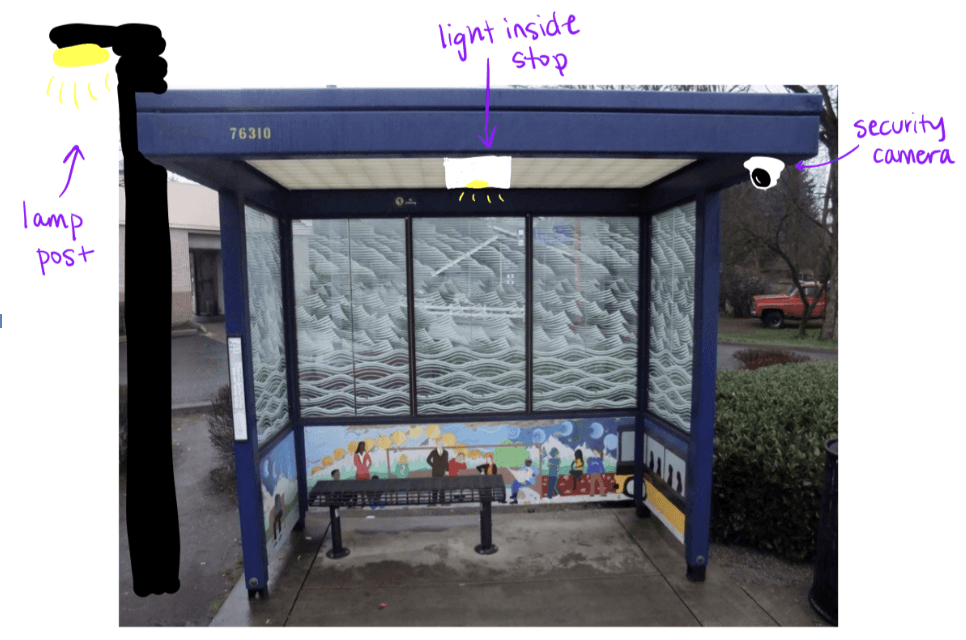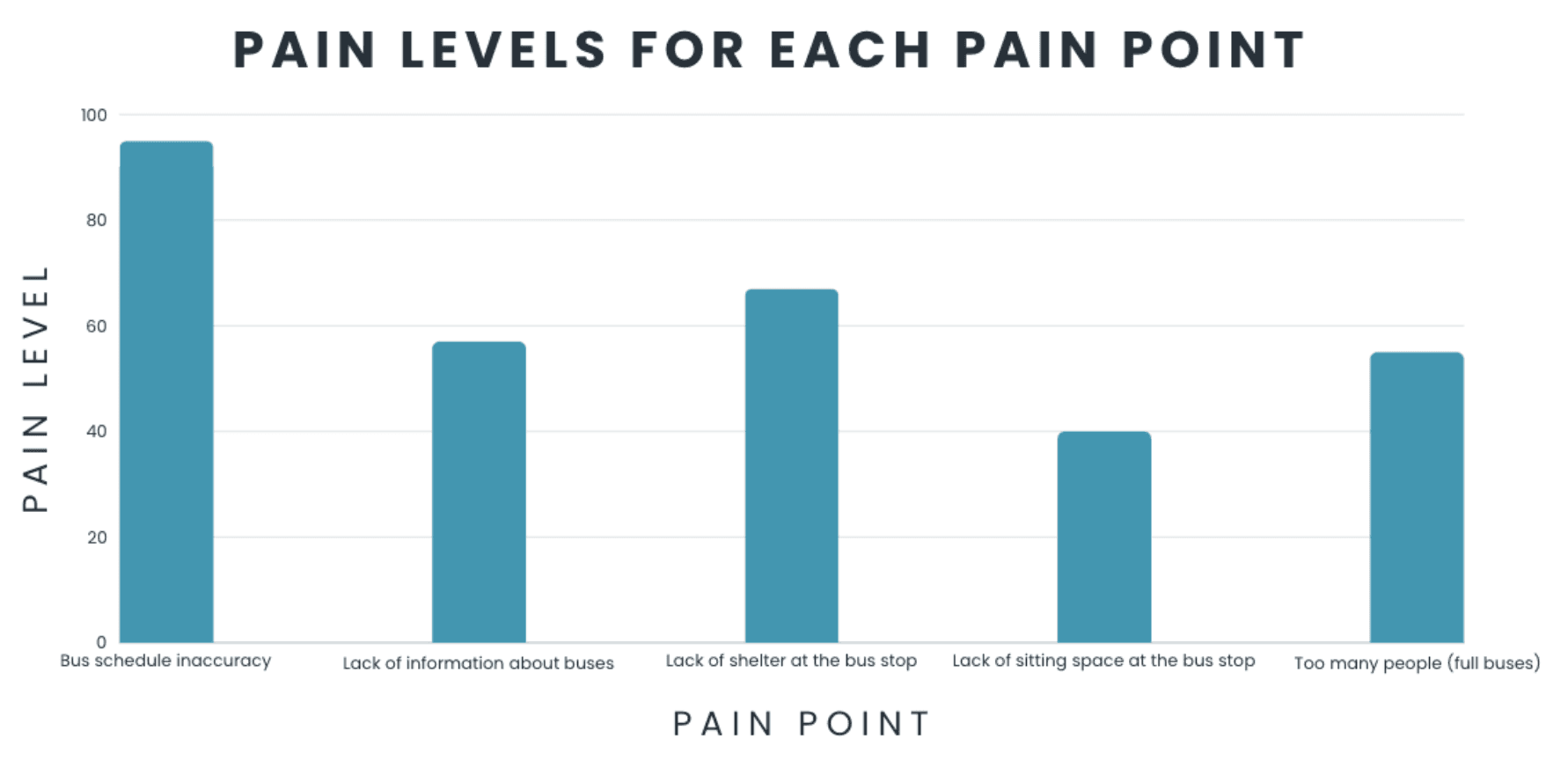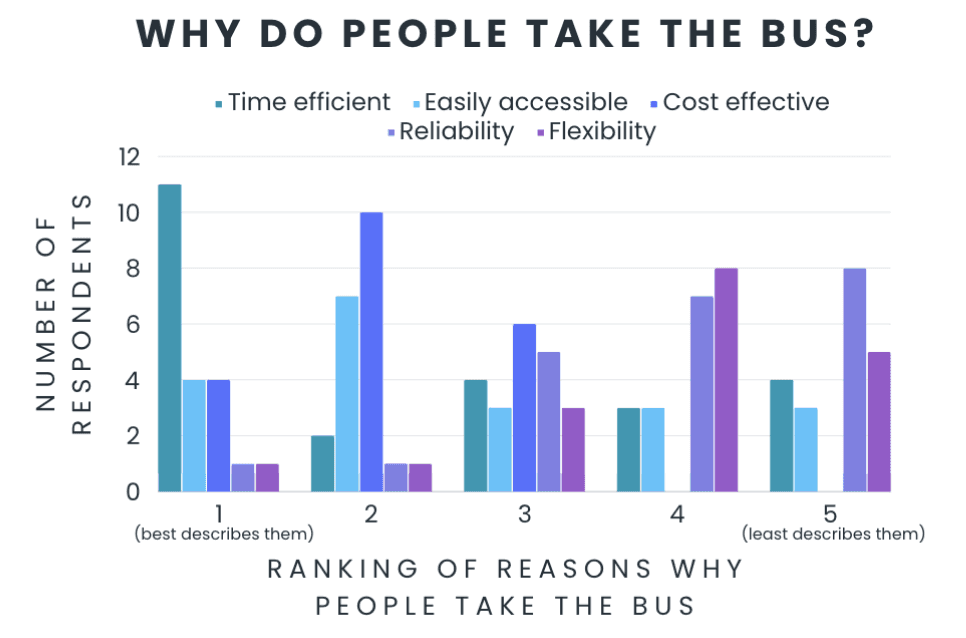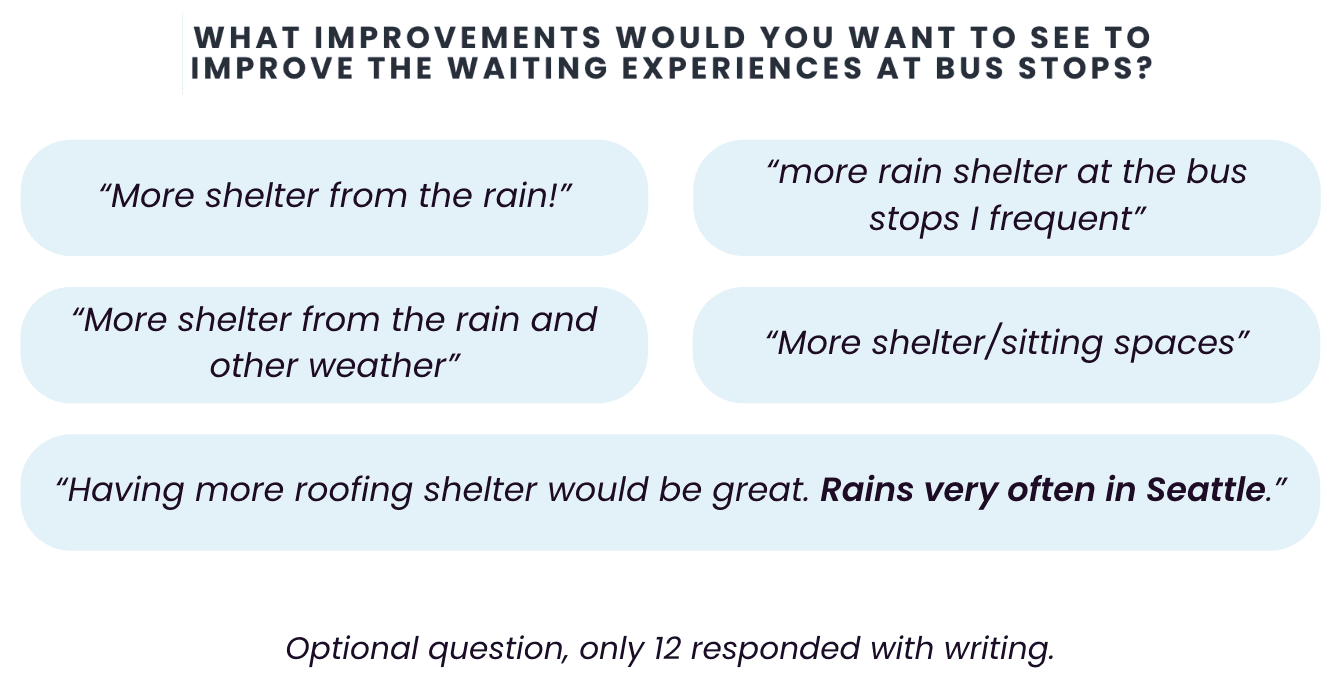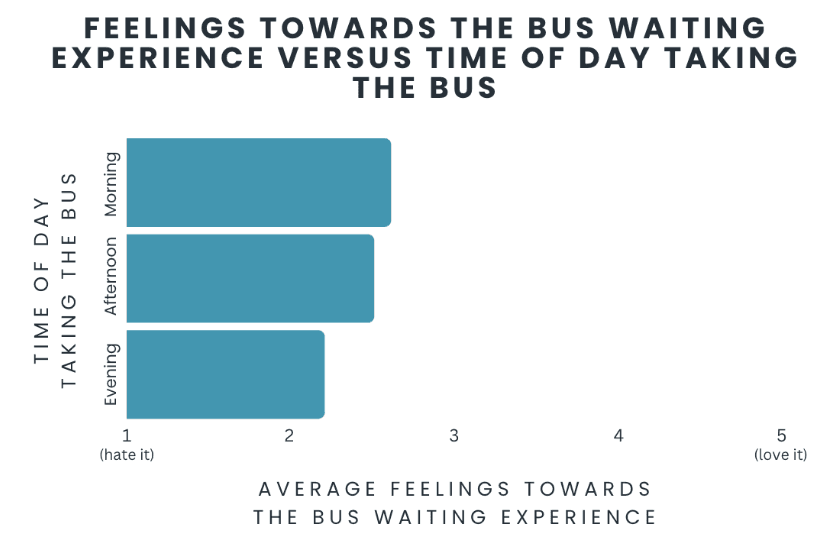Improving the Bus Waiting Experience Research Project
OBJECTIVE
To investigate the experiences of commuters waiting for the bus on or around the University of Washington campus so we can recommend improvements.
OVERVIEW
COURSE: HCDE 313: User Research
TIMELINE: 10 Weeks, Fall 2023
TOOLS: Observational Field Study, Interview Study, Survey
PROBLEM CONTEXT
Public transportation, especially the bus system, is relied on by thousands of people in Seattle, yet very few people have consistently positive experiences with the King County Metro Transit. Much of that comes from the time on the bus itself, but people also frequently feel negative emotions surrounding the bus waiting experience, which this research study focuses on.
Throughout the 10 week quarter, I conducted an observational field study, interviews, and a survey to investigate the experiences of commuters waiting for the bus on or around the University of Washington campus. The guiding question that directs this study is: “How can we improve the experience of waiting for the bus on the UW campus and the Seattle area?”
OBSERVATIONAL FIELD STUDY
METHODS:
This observational field study was conducted over two days at three bus stop locations around the UW campus, each session lasting 20-45 minutes between 4:00 to 6:00 PM—a peak commute time. The locations included Stevens Way & Okanogan Ln (E), 45th Street & Memorial Way (E), and 15th Ave NE & NE 42nd St (N), selected for their size, popularity, and seating availability. Seating was crucial for note-taking and to avoid appearing as loitering.
Categories of focus—food and drink, built environment, possessions, media consumption, demographics, traffic, information and communication, and overall experience—were predetermined and used to guide observations. This structured approach ensured a focused analysis despite the busy environment. While not every category was thoroughly recorded, the most relevant trends emerged.
Notes on commuter interactions were taken in bullet format with timestamps on a Google Document, then cleaned up after each session. An affinity analysis organized these notes into groups, revealing key pain points in the bus waiting experience.
RESULTS AND RECOMMENDATIONS:
Using trends from an affinity analysis, key pain points were identified: bus schedule accuracy, bus size vs. number of commuters, and availability of space/shelter at the stop.
Prioritized Pain Points:
Bus schedule accuracy – Late buses affected commuters, leading to anxiety. Commuters were seen pacing, checking phones, and looking down the road:
“Person is now pacing back and forth by the bus stop sign.”
“Everyone tends to look in the direction where the bus is coming from… People strain their necks and take steps forward looking for the bus.”
Recommendation: Improve real-time location services and allow passengers on buses to update schedule info.
Bus size vs. number of commuters – During rush hour, overcrowding occurred with 40-foot buses. In two sessions, people couldn’t board due to lack of space:
“372 comes. It’s one of the smaller buses. Half of the people at the stop start walking towards it as it pulls up. They form a long line that moves really slowly…”
“44 comes, ‘BUS IS FULL’… Only one person gets out, and the bus remains full. No one is let on.”
Recommendation: Use 60-foot articulated buses during rush hour and provide real-time bus capacity info on apps.
Space/Shelter availability – Comfort at the stop greatly affected commuter satisfaction. People tended to space out and seek shelter when available:
“People are starting to walk up to the stop. They gravitate to the shelter and the bus stop sign.”
Recommendation: Increase sheltered seating, especially at high-traffic stops, to improve the waiting experience.
DISCUSSION:
The results show that 40-foot buses are insufficient during rush hour, bus schedules are often inaccurate and not trusted, and people prefer space at bus stops to avoid standing too close to others, though seating and shelter are still important.
Study Limitations:
The observational nature limited the ability to understand the “why” behind people’s actions, making some notes subjective.
No rainy weather was observed, which would have impacted findings on shelter availability.
All observations occurred on similar weather days in the late afternoon, limiting the scope.
Next Steps:
Future studies should involve rainy conditions and incorporate interviews to explore the thought processes behind commuters’ choices, such as checking bus schedules, waiting behaviors, and reactions to the bus arriving.
Overall, the study was eye-opening, revealing interesting insights into crowd behavior during rush hour, even if some behaviors seemed predictable.
INTERVIEW STUDY:
METHODS:
Three participants were interviewed—two in-person and one on Zoom. The in-person participants were classmates from HCDE 313, interviewed around class time, while the Zoom participant was a friend interested in the study.
Even for the in-person interviews, I set up a Zoom meeting on my laptop to record audio and transcribe captions using Zoom’s audio caption feature. This also allowed me to refer to my typed-out, pre-planned questions while maintaining a conversational tone. The interviews lasted 20-30 minutes each, with the audio recordings transcribed and analyzed afterward by grouping notes to identify trends.
Key Questions Asked:
What do you do while waiting for the bus?
How do you feel about the bus waiting experience?
Can you describe experiences with bus schedule inaccuracies or full buses?
What are your feelings about space and shelter at bus stops?
These questions aimed to address a key limitation of my previous observational study: understanding the feelings and reasons behind commuters' actions while waiting for the bus.
RESULTS AND RECOMMENDATIONS:
After analyzing the interviews, three key pain points emerged: inaccurate bus schedules, lack of communication about bus changes, and inadequate bus stop assets.
1) Inaccurate bus schedules: All participants expressed frustration with apps showing incorrect bus times, leading to disruptions in their day.
“When I was working, I would check for the time just to make sure I wasn't gonna be late and even that I was still late a lot because these buses are super inaccurate with timing… It's really, really annoying, especially when you have a place to be.”
“I would trust that sign more than I trust Maps… You'd expect it to be coming directly from the Metro instead of going through a third party like Maps.”
Recommendations:
Install live update signs at bus stops to improve accuracy.
Add a feature on the app where passengers can update bus location and timing, fostering community while improving real-time information.
Figure 1. Adding a “Live Person Updates” section to see information provided by a real person.
2) Lack of communication: Participants noted issues with full buses and route changes that weren’t communicated, affecting their decisions.
“If I'm deciding between taking the bus or walking... I might just walk rather than try and cram into this bus.”
“The bus stop moved because of construction... and the next time that bus came to the temporary spot, it was way later than I needed to be there so I ended up scrapping those plans.”
Recommendations:
Add alerts for route changes on apps and physical signs at the bus stop.
Show bus fullness on apps to help riders decide if they want to wait for the next bus.
Figure 2. Adding an “About this Bus” section to provide information such as fullness of bus.
3) Inadequate bus stop assets: Participants frequently mentioned discomfort due to a lack of seating and shelter.
“The benches in the covered portion were completely full... I was just getting drenched, waiting for the bus.”
“The other biggest pain point is, when there are benches, there's not nearly enough benches; they're always filled. There's never anywhere to sit.”
Recommendations:
Install benches at every bus stop and larger shelters at busier stops.
Add signs encouraging priority seating for elderly or disabled passengers.
Install cameras to increase safety at bus stops.
Figure 2. A sign that encourages priority seating for mothers, elderly, & people with disabilities.
DISCUSSION:
The study highlights that bus schedule times on apps are often unreliable, there's inadequate communication about changes affecting buses, and bus stop conditions are uncomfortable.
Limitations: The study’s sample was limited to UW students with similar experiences, and only three interviewees were included, missing broader perspectives from the Seattle bus-riding community.
Insights: The interviews provided valuable emotional and experiential insights that addressed gaps from the initial observational study, including the impact of rain on waiting experiences.
Future Directions: Future studies should include a more diverse participant pool and explore varied reasons for bus usage. Surveys will help validate findings, capture additional perspectives, and identify further pain points.
Surprises: Two interviewees mentioned bus stops in Europe, and none used the OneBusAway app, despite its origins at UW, which was unexpected given its local relevance.
SURVEY:
The goal of the survey was to provide quantitative data that will validate what has already been found in my field and interview research with more opinions and to open the floor for any other pain points or suggestions for improvement.
METHODS:
Platform
Google Forms: sent to UW students through various mediums (Snapchat, Slack, Text)
Analysis
Google Spreadsheets and organic groupings and notetaking
Participants
Collected responses from 21 participants (limitation: small sample size)
Inclusion criteria: has commuted before and has experience taking buses around University of Washington
RESULTS:
1) Bus schedule inaccuracy is the pain point that most affects bus riders.
The top reason for why people choose to take the bus is to increase time efficiency: getting from A to B faster.
Most people often pass time as they wait for the bus by going on their phone to check the bus schedule.
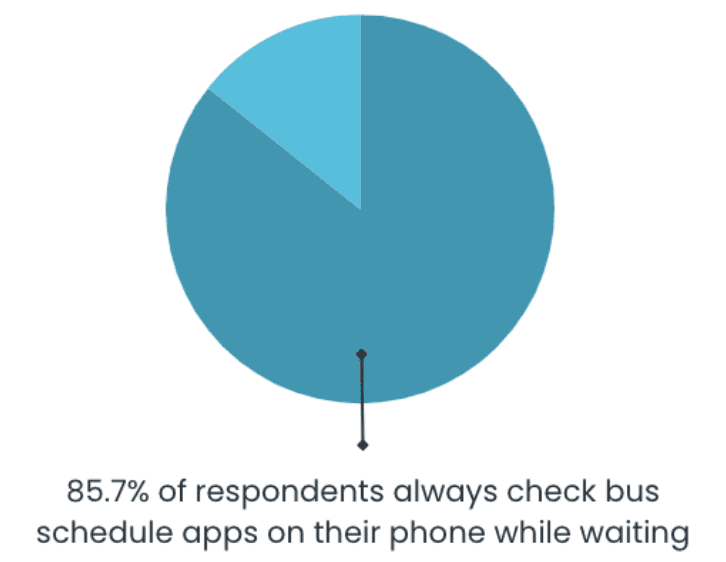
DISCUSSION
Implications:
Time is most important! Most people are trying to get somewhere efficiently.
They plan their schedules around the bus schedule so if the time is inaccurate, that will cause a large pain that may affect their day.
Recommendations:
Installing a live update sign with timing information at every stop
Better live information software: possibly add feature to bus schedule app where passengers on the bus can update the time and location too
Considerations:
Some people use Google Maps, Apple Maps, or OneBusAway; all different platforms
2) People generally feel that there is not enough roofing shelter at bus stops on or near UW.
DISCUSSION
Implications:
Since it rains so often in Seattle, many people’s waiting experiences are tainted by having to get drenched!
More shelter would better the waiting experiences for many people who would otherwise have to get drenched.
Recommendations:
Shelter at every bus stop!
More shelter at highly populated bus stops
3) People who more frequently take the bus in the evening think worse of the experience than those who take it during the day.
DISCUSSION
Considerations:
Smaller sample size for number of people who more frequently take the bus during the evenings rather than morning/afternoon (4 versus 9/8)
Implications:
Factors that are more associated with the evening cause a worse experience waiting for the bus
SAFETY!
Dark, can’t see your surroundings well → fear
Later at night = more impatient to go somewhere
Recommendation:
Installing cameras and light fixtures at bus stop → feel more safe at night!
REFLECTION:
What I need to do differently in my next survey research study:
Modify my survey to prevent some overlapping questions
Have a peer read over my survey again after it is critiqued before sending it out
Hardest part:
Limitation of small sample size
Synthesizing all the data gathered from 13 questions (so much)
Finding interesting trends
What was fun or surprised me:
Cute idea in a response: “...create murals at each bus stop with qr codes about the city…” to foster “...some kind of interaction or playful engagement at the bus stop [to] make the idle waiting time more fun!”
Check out the full reports for the observational field study, interview study, and survey here!
FUTURE WORK:
While the quarter (and therefore the project) ended, here's what my next steps would be:
User testing with my design recommendation sketches (from all three studies)
Gather thoughts: support or opposition
See what’s feasible
Figure out who to contact in Seattle to present my case!

